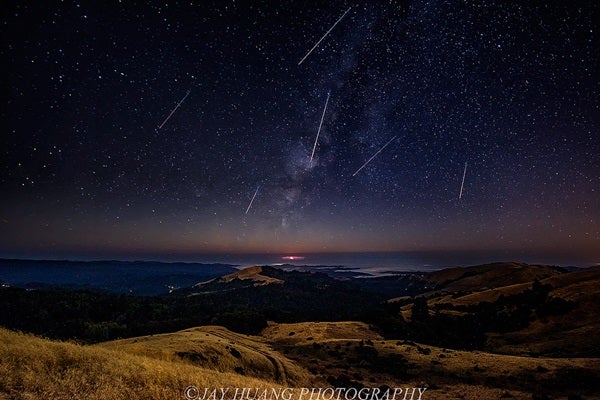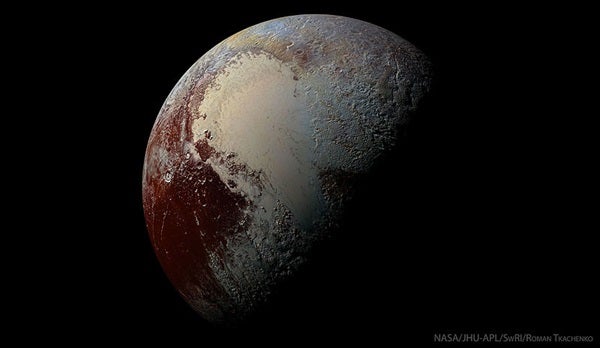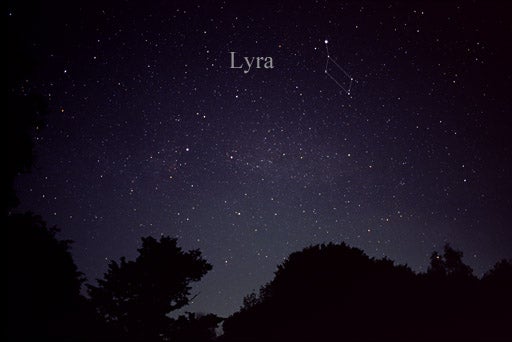Friday, July 28
The waxing crescent Moon appears about one-third illuminated this evening, when it lies just 3° above brilliant Jupiter. The two stand about 25° high in the southwest an hour after sundown and look spectacular from then until they set after 11 p.m. local daylight time. Although the naked eye and binoculars show this conjunction best, a telescope delivers great views of magnitude –1.9 Jupiter all week. The giant planet’s disk spans 35″ and shows a wealth of detail in its massive atmosphere.
Saturday, July 29
Mercury pops out of the twilight glow this evening as the sky begins to darken. The innermost planet lies 27° east of the Sun tonight, its greatest elongation for this evening apparition (the configuration officially occurs at 1 a.m. EDT on the 30th). Look for it 30 minutes after sunset, when it lies some 8° above the western horizon. The planet should be fairly easy to spot because it shines brightly, at magnitude 0.3. (Use binoculars if you can’t see it with your naked eye.) Through a telescope, Mercury appears 8″ across and slightly less than half-lit.
The Southern Delta Aquarid meteor shower reaches its peak overnight, but meteor rates remain essentially the same from July 27 to August 1. And with the nearly First Quarter Moon setting around midnight local daylight time, early morning viewing conditions should be ideal. The meteors appear to radiate from the constellation Aquarius, which rises in late evening and appears highest in the hours before dawn. At its best, the shower produces 20 to 25 meteors per hour under a dark sky, though the highest rates occur at tropical locations and in the Southern Hemisphere.
Sunday, July 30
First Quarter Moon arrives at 11:23 a.m. EDT. Our satellite won’t rise until around 1:30 p.m. local daylight time, however, so observers in the Americas won’t see it precisely half-lit. As darkness falls this evening, the Moon appears about 55 percent illuminated and resides among the background stars of Libra the Scales.
By the time morning twilight starts to paint the sky, brilliant Venus already dominates the scene. The planet rises around 3 a.m. local daylight time and stands 10° high at the start of twilight an hour later. It’s hard to mistake Venus for anything else — at magnitude –4.0, it shines far brighter than any other object in the morning sky. Although the view with the naked eye or through binoculars is dazzling, you’ll need a telescope to see the planet’s 15″-diameter disk, which appears nearly three-quarters illuminated. Venus treks rapidly eastward relative to the background stars all week. This motion carries it from Taurus the Bull into Orion the Hunter today, but it remains in this non-zodiacal constellation for just two days. On August 1, the planet will cross into Gemini the Twins.
Monday, July 31
Pluto reached the peak of its 2017 appearance earlier this month, and it remains a tempting target for those with an 8-inch or larger telescope. The 14th-magnitude world is visible all night among the background stars of northeastern Sagittarius, some 1.3° east-southeast of 3rd-magnitude Pi (p) Sagittarii. See “In pursuit of Pluto” in the July Astronomy for complete details on finding this world.
Tuesday, August 1
Jupiter resides in front of the 11th-magnitude spiral galaxy NGC 4941 this evening. Although visual observers have no hope of seeing the two in the same telescopic field of view, astroimagers might be able to capture both. Plan on taking multiple exposures to show the bright planet, its fainter moons, and the dim spiral. Perhaps your best bet is to capture a series of images over several nights to record the planet’s passage by the galaxy.
Wednesday, August 2
The waxing gibbous Moon stands at its highest point above the southern horizon as darkness falls this evening. If you look a few degrees to its lower left, you can’t miss Saturn. The glorious ringed planet shines at magnitude 0.3 and shows up nicely against the backdrop of southern Ophiuchus on any clear night. When viewed through a telescope, Saturn’s globe measures 18″ across while its dramatic ring system spans 40″ and tilts 27° to our line of sight.
The Moon reaches apogee, the farthest point in its orbit around Earth, at 1:55 p.m. EDT. It then lies 251,671 miles (405,025 kilometers) from Earth’s center.
Thursday, August 3
Uranus’ eastward motion against the background stars comes to a halt at 6 a.m. EDT. This so-called stationary point marks the beginning of the best period to observe the outer planet. Uranus rises before midnight local daylight time and appears more than halfway to the zenith in the southeastern sky as morning twilight commences. The magnitude 5.8 planet lies in Pisces, 1.2° north of magnitude 4.3 Omicron (o) Piscium. A telescope reveals Uranus’ blue-green disk, which spans 3.6″.
Friday, August 4
Look overhead around 11 p.m. local daylight time any day this week and your eyes will fall on the brilliant star Vega in the constellation Lyra the Harp. At magnitude 0.0, Vega is the brightest member of the prominent Summer Triangle asterism. The Triangle’s second-brightest star, magnitude 0.8 Altair in Aquila the Eagle, lies some 35° southeast of Vega. The asterism’s dimmest member, magnitude 1.3 Deneb in Cygnus the Swan, stands about 25° east-northeast of Vega. Although the waxing gibbous Moon diminishes the luster of stars this week, the Summer Triangle remains conspicuous.
Saturday, August 5
Distant Neptune reaches opposition and peak visibility in just a month, but the view now is essentially the same. The ice giant planet rises around 9:30 p.m. local daylight time and climbs nearly halfway to the zenith in the southern sky by 3 a.m. The magnitude 7.8 planet lies in Aquarius, 2° east of 4th-magnitude Lambda (l) Aquarii. You’ll need binoculars to spy Neptune and a telescope to see its blue-gray disk, which spans 2.4″.
Sunday, August 6
Asteroid 89 Julia should be relatively easy to find through small telescopes south of the Great Square of Pegasus. Your signpost for finding this magnitude 9.6 space rock is a squashed box of four 5th-magnitude stars: 55, 57, 58, and 59 Pegasi. The box lies 6° south of magnitude 2.5 Markab (Alpha [a] Peg), the star that marks the Great Square’s southwestern corner. Tonight, Julia stands 1.5° south of 59 Peg. If you sketch the field and then return to the same area a night or two later, you should be able to detect the asteroid’s movement relative to the stellar background.












